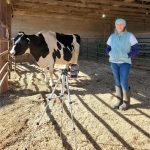
Cheese prices rose again in October, capping the second major cheese run-up of the pandemic, as a second round of government purchases stoked demand. This ended at the beginning of November, when daily cash market prices of both blocks and barrels dropped sharply for more than a week as markets anticipated federal purchases winding down.
Bright spots for dairy in the year’s first three quarters of data include increases in total sales of fluid milk, yogurt and butter, which have been buttressed by strong retail demand. Cheese, meanwhile, has seen mixed progress in commercial use year-to-date, with use that’s been higher for American-type cheese but slightly lower for other types. Export growth has also been strong for dry skim milk, whey products and other than American-type cheese, which has offset the drop in its domestic use. The DMC margin dipped a toe below $9.50 per cwt in September, due to strengthening corn and soybean meal prices that followed modest, but steady declines for the year to that point.
Commercial Use of Dairy Products
Fluid milk sales began this year below year-earlier levels in January and February, but a large spike in use during March, as the pandemic first hit, managed to boost total first quarter sales above last year. Fluid sales have been consistently up on a rolling 3-month basis since then, through August. Domestic commercial use of butter was almost three percent higher than a year ago for 2020 to date through September, with particularly strong growth in the double digits during March through June.
Following drops in July and August, September growth was again robust, bringing the third quarter in just about flat. Heavy reliance on food-service sales in the domestic market created stronger headwinds for cheese during the first three quarters of 2020. This was particularly the case for other than American types, much of which is mozzarella, and for which monthly growth in domestic commercial use was modestly positive only in January and June.
U.S. consumption was more robust for American-type cheese, beginning in May, which helped keep domestic use of all cheese just a bit above flat for the year to date through the third quarter. Domestic use of dry skim milk and whey products was sharply lower year to date through September, but this was either mostly, or entirely, offset by strong export growth.
Domestic use of whole milk powder was up for the year to date by almost 25%, reflecting strong demand in commercial baking and confectionary use. Aggregate use, on a milk equivalent basis, was generally stronger during the third quarter.
U.S. Dairy Trade
The third quarter produced strong export growth, mostly well into double digits, for all major product categories except lactose and whole milk powder, for which robust domestic use competed heavily with export sales. Lactose exports began the year strong but have been mostly lower since May. Import were lower, by low double digits, for most of the major import categories as well as in total, with the major exception being milk protein concentrate.
Milk Production
Annual growth in the national milking cow herd slowed a bit in September, when it rose by 30,000 cows from a year earlier. Herd growth in July and August was about 10,000 cows higher than this. However, a September spurt in production per cow pushed milk production up by 2.3 % from a year earlier. Production growth in July and August was just under 2% above a year ago. Growth in milk solids production was significantly higher than liquid milk production growth during the third quarter, based on data from USDA’s Economic Research Service.
Dairy Products
Total U.S. cheese production was essentially unchanged during the third quarter, with gains in American types, particularly cheddar, offset by crops in other types, including mozzarella. Butter production was 5% higher than a year ago during the quarter; domestic use was flat, but strong export growth absorbed the excess and drew down stocks a bit as well. Total production of dry skim milk products grew along with butter.
Dairy Product Inventories
Commercial stocks of dry skim milk at the end of September were 5% lower in volume than a year earlier, but 24% lower year-over-year as measured by days of total commercial use in stock, due to a 20% increase in total use that month. Dry whey and cheeses saw smaller declines, while butter inventories increased by both measures. Still, the inventory situation was very different from that seen last spring, with September dry skim milk stockpiles only 60% of what they were at the end of April and butter stocks down significantly from May. Cheese inventories were also lower at the end of September than in May.
Dairy Product and Federal Order Class Prices
Changes in the monthly dairy product prices in the National Dairy Product Sales Report (NDPSR) from September to October were again relatively modest for butter, nonfat dry milk and, to some extent, for dry whey. DNPSR cheese prices were again the exception, rising strongly in October after falling sharply a month before, for their second major price run-up this year.
Another round of USDA food-box purchases were a key driver of the October rise. Remaining often out of sync, as it has for the past several months, the Class I price dropped more than $3/cwt I October while Class III rose over $5/cwt, portending another month of large negative producer price differentials that month.
Retail prices for whole and low-fat fluid milk were lower in October than a month earlier, by larger amount than typical in recent months. Natural cheddar cheese prices were slightly lower at retail while butter rose slightly.
Milk and Feed Prices
The downswing in cheese prices that started in July continued in September, taking milk prices down with it. The September U.S. average all-milk price was $0.90/cwt lower than the August price and $2.60/cwt below July’s. Rising corn and soybean meal prices combined with the lower milk price to drop the Department margin under the Dairy Margin Coverage (DMC) program just under $9.50 per cwt maximum level coverage under the program, the fourth time this year when the margin came in below this level.
Looking Ahead
As of mid-November, dairy futures indicated that butter and nonfat dry milk prices would gradually rise through next year, while dry whey prices would remain fairly stable. Cheese prices, on the other hand, were expected to drop, from almost $2.50/lb. in November, to around $1.75/lb. by the end of the winter months, which would bring milk prices down by about $3/cwt over that period.
This outlook assumes that significant USDA purchases, particularly the food-box purchases that have been concentrated over relatively short periods this year, will end; it also takes account of growing milk production. With feed costs projected to rise over this period, the DMC margin is expected to drop below $9.50/cwt early in 2021 and generate payments average around $1/cwt through at least the first half of 2021.

























